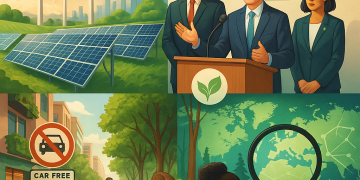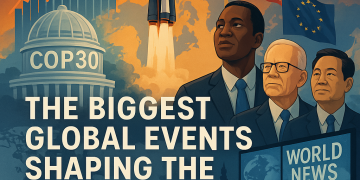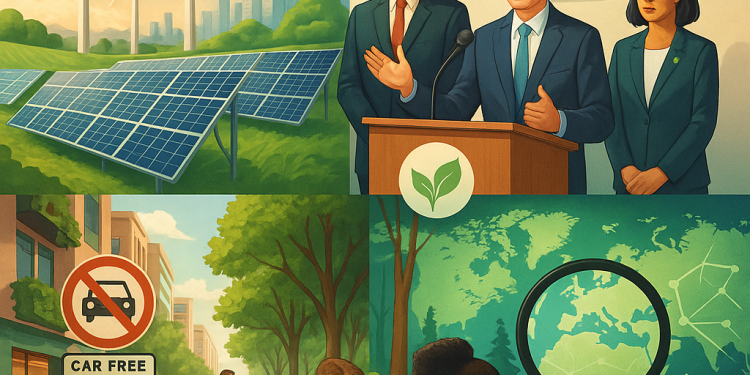Introduction: The Urgency of a Global Challenge
Few topics unite the world—or divide it—like world climate change. As record-breaking heatwaves, devastating wildfires, and rising sea levels become the new normal, it’s clear: we face a planetary emergency. But the story isn’t all doom and gloom. Across continents, countries are experimenting, innovating، and implementing bold international environmental solutions. These efforts are rewriting the script on global warming response, influencing policy, business, and daily life.
How are governments, businesses, and communities rising to the challenge? Which climate policies are working, and what creative green world initiatives offer hope for our future? Let’s explore how the globe is fighting back—one solution at a time.
1. The Science: Why Climate Action Can’t Wait
Scientists agree: human activity—burning fossil fuels, deforestation, and industrial farming—is driving global warming. The impacts are everywhere: extreme weather, droughts, flooding, shrinking glaciers, and the loss of species.
But the same science shows that solutions are within reach—if we act decisively. Limiting warming to 1.5°C (the Paris Agreement target) can prevent the worst impacts, but requires rapid, large-scale changes.
2. The Paris Agreement: A Global Framework
In 2015, almost every country on Earth signed the Paris Agreement, pledging to cut emissions and invest in resilience. This treaty sets the foundation for climate policies worldwide, with each nation committing to Nationally Determined Contributions (NDCs). Every five years, these targets are reviewed and (hopefully) increased in ambition.
Key Features:
- Limit global temperature rise to “well below” 2°C.
- Net-zero emissions by mid-century.
- Support for developing nations to adapt and innovate.
3. Leading Countries in Climate Solutions
a. Europe: Ambitious Goals and Green Deals
European Union: The EU leads with the Green Deal, aiming for carbon neutrality by 2050. Policies include:
- Phasing out coal and investing in renewables (solar, wind, hydro).
- Emissions trading systems that put a price on carbon.
- “Fit for 55” package: Reduce emissions 55% by 2030.
- Massive investment in electric vehicles, public transit, and building retrofits.
Nordic Countries: Denmark, Sweden, and Norway are world leaders in wind power, green tech, and sustainable city planning.
b. China: Clean Energy Giant
China is both the world’s biggest emitter and the biggest investor in clean energy. Recent actions include:
- Building more wind and solar capacity than any other country.
- Pledging to reach peak emissions before 2030 and carbon neutrality by 2060.
- Expanding electric vehicle use and green public transit in megacities.
- Massive reforestation campaigns.
c. United States: Shifting Gears
After a period of uncertainty, the US is back in the climate game:
- The Inflation Reduction Act of 2022 injects billions into clean energy, EV tax credits, and carbon capture tech.
- States like California and New York have aggressive climate laws, requiring 100% clean electricity by 2045/2050.
- The US leads in innovation for batteries, grid tech, and sustainable agriculture.
d. Developing Nations: Innovation Under Pressure
India: Investing in solar farms, banning single-use plastics, and creating “solar villages” in rural areas.
Kenya: Leading Africa with geothermal energy and reforestation.
Costa Rica: Nearly 100% of electricity comes from renewables, with aggressive conservation and eco-tourism.
4. International Environmental Solutions: What’s Working?
a. Renewable Energy Revolution
Solar, wind, hydro, and geothermal are expanding rapidly worldwide.
- Germany: The Energiewende (energy transition) policy transforms its entire grid toward renewables.
- Morocco: Home to the world’s largest solar farm (Noor Complex).
b. Nature-Based Solutions
- Mangrove Restoration: Indonesia, Bangladesh, and Caribbean nations protect and plant mangroves to fight coastal erosion and absorb CO₂.
- Urban Greening: Singapore’s “city in a garden” approach incorporates parks, green roofs, and vertical gardens.
c. Climate Adaptation
- Flood Barriers: The Netherlands’ sophisticated sea walls protect cities below sea level.
- Water Management: Israel leads in desalination and drip irrigation, turning deserts green.
d. Green Technology and Innovation
- Smart Grids and Batteries: South Korea and Japan invest in “smart” energy infrastructure.
- Sustainable Building: Dubai, Vancouver, and Sydney are home to world-leading green buildings.
- Carbon Capture: Canada, the US, and Norway pilot large-scale projects to suck CO₂ from the air and store it underground.
5. Policies and Agreements Shaping Global Warming Response
a. Emissions Trading and Carbon Taxes
Europe’s emissions trading system and carbon taxes in Canada, Switzerland, and Sweden set economic incentives for businesses to cut emissions.
b. Bans and Phase-Outs
- Coal phase-out: The UK and Austria have closed all coal plants.
- Combustion engine bans: Norway will end sales of gasoline cars by 2025; other countries soon after.
c. International Climate Funds
Wealthier nations fund climate adaptation and mitigation in vulnerable countries—key to a fair and effective global response.
6. Challenges: Why Progress Is Hard
- Politics: Shifting priorities, elections, and lobbying from fossil fuel interests can slow action.
- Finance: Upfront costs for green tech can be high, especially for poor countries.
- Equity: Developing nations need resources and support; climate justice remains a global challenge.
- Behavior: Changing how billions of people live, eat, move, and consume is no small feat.
7. Green World Initiatives: Innovative Ideas from Around the Globe
a. Urban Mobility
- Copenhagen: Half of all trips are by bike—thanks to safe lanes and city planning.
- Bogotá: The “Ciclovía” closes city streets to cars every Sunday for cyclists and pedestrians.
b. Plastic-Free Movements
- Rwanda: One of the first countries to ban plastic bags nationwide.
- European Union: Bans on single-use plastics and microbeads.
c. Rewilding and Conservation
- Scotland: Reintroducing native species and restoring wild habitats.
- Australia: Great Barrier Reef restoration with coral nurseries and marine parks.
d. Citizen-Led Change
- Fridays for Future: Started by Greta Thunberg in Sweden, now a global youth movement.
- Community Solar: Local cooperatives let neighborhoods invest in shared renewable projects.
8. Table: Notable Climate Solutions by Country
| Country | Solution/Initiative | Impact |
|---|---|---|
| Germany | Energiewende (energy transition) | Grid transformation |
| China | Largest wind & solar investment | Clean energy expansion |
| Costa Rica | Nearly 100% renewable electricity | Low emissions, eco-tourism |
| Kenya | Geothermal energy leadership | Clean energy, rural access |
| Netherlands | Advanced flood control | Sea level adaptation |
| Rwanda | Nationwide plastic ban | Cleaner cities, global model |
9. Global Climate Policies and the Role of the Individual
Climate policies work best when supported by businesses and individuals:
- Choose green energy providers.
- Reduce meat and dairy in your diet.
- Walk, bike, or use public transport when possible.
- Support political leaders and companies committed to climate action.
10. Resources for More on International Environmental Solutions
- UN Climate Change
- IPCC – Intergovernmental Panel on Climate Change
- World Resources Institute
- Global Alliance for Climate-Smart Agriculture
- National Geographic – Climate Change
Conclusion: A Greener Future Is Possible—If We Act Together
World climate change is the challenge of our era. But the story isn’t finished. From policy reforms and high-tech breakthroughs to ancient wisdom and local action, international environmental solutions are multiplying. Every country—rich and poor, large and small—has a part to play in our collective global warming response.
It won’t be easy, but the momentum is real. By sharing ideas, resources, and inspiration, the world can meet this crisis—and build a future defined by resilience, innovation, and hope


















































